Timeline of discovery of Solar System planets and their moons
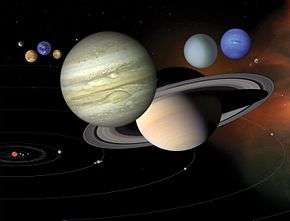 |
| Objects |
|---|
| Lists |
|
|
The timeline of discovery of Solar System planets and their natural satellites charts the progress of the discovery of new bodies over history. Each object is listed in chronological order of its discovery (multiple dates occur when the moments of imaging, observation, and publication differ), identified through its various designations (including temporary and permanent schemes), and the discoverer(s) listed.
Historically the naming of moons did not always match the times of their discovery. Traditionally, the discoverer enjoys the privilege of naming the new object; however, some neglected to do so (E. E. Barnard stated he would "defer any suggestions as to a name" [for Amalthea] "until a later paper"[1] but never got around to picking one from the numerous suggestions he received) or actively declined (S. B. Nicholson stated "Many have asked what the new satellites" [Lysithea and Carme] "are to be named. They will be known only by the numbers X and XI, written in Roman numerals, and usually prefixed by the letter J to identify them with Jupiter."[2]). The issue arose nearly as soon as planetary satellites were discovered: Galileo referred to the four main satellites of Jupiter using numbers while the names suggested by his rival Simon Marius gradually gained universal acceptance. The International Astronomical Union (IAU) eventually started cleaning up the naming business in the late 1970s.
Key
In the following tables, planetary satellites are indicated in bold type (e.g. Moon) while planets and dwarf planets, which directly circle the Sun, are in italic type (e.g. Earth). The tables are sorted by publication/announcement date. Dates are annotated with the following symbols:
- i: for date of first imaging (photography, etc.);
- o: for date of first human visual observation, either through telescope or on photographic plate (the true discovery moment);
- p: for date of announcement or publication.
In a few cases, the date is uncertain and is then marked "(?)".
* Note: Moons marked by an asterisk (*) had complicated discoveries. Some took years to be confirmed, and in several cases were actually lost and rediscovered. Others were found in Voyager photographs years after they were taken.
- Color legend
The planets and their natural satellites are marked in the following colors:
|
|
- Designations
- Other designations are synonyms or periphrases sometimes encountered for the object.
- Permanent designations (of planetary satellites) are explained here.
- Temporary designations are explained here.
Prehistory
| Prehistory | ||||
|---|---|---|---|---|
| Name | Image | Other designation | Notes | |
| Sun |  | Star | In Ptolemy's geocentric model, the Earth was believed to be at the center of the cosmos. Seven planets were placed in orbit around it in an order of increasing distance from the Earth, as established by the Greek Stoics: the Moon, Mercury, Venus, the Sun, Mars, Jupiter and Saturn. This list included two objects, the Sun and the Moon, which are no longer considered to be planets. Anaxagoras first proposed that the Sun is a star around 450 BC, though this was not widely accepted until the 17th century and not proven conclusively until the 19th.[3] | |
| Moon | .jpg) |
Earth I | In the Copernican system, the Moon was considered to be no longer a planet but a natural satellite of the Earth, and was originally thought to be the only body in that system whose revolution was not centered on the Sun. | |
| Mercury | .jpg) |
1st planet | The inner planets, Mercury and Venus, and the outer planets, Mars, Jupiter and Saturn, were identified by ancient Babylonian astronomers in the 2nd millennium BC.[4]
By Aristarchus of Samos, and later in Nicolaus Copernicus' heliocentric system (De Revolutionibus Orbium Coelestium, 1543), the Earth came to be considered a planet revolving with the other planets around the Sun, in the following order of distance from the Sun: Mercury, Venus, Earth, Mars, Jupiter, and Saturn. The Sun, now situated near the center of revolution, was no longer considered a planet. | |
| Venus | .jpg) | 2nd planet | ||
| Earth | .jpg) | 3rd planet | ||
| Mars | .jpg) |
4th planet | ||
| Jupiter | 5th planet | |||
| Saturn | 6th planet | |||
17th century
| 17th century | |||||
|---|---|---|---|---|---|
| Date | Name | Image | Permanent designation | Discoverer(s) and notes | |
| 1610s | |||||
| o: January 7, 1610 p: March 13, 1610 |
Ganymede |  | Jupiter III | Galileo[5][6] discovered the Galilean moons. These satellites were the first celestial objects that were confirmed to orbit an object other than the Sun or Earth. Galileo saw Io and Europa as a single point of light on January 7, 1610; they were seen as separate bodies the following night.[7] | |
| Callisto | .jpg) | Jupiter IV | |||
| o: January 8, 1610 p: March 13, 1610 |
Io | 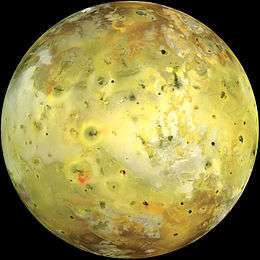 | Jupiter I | ||
| Europa | 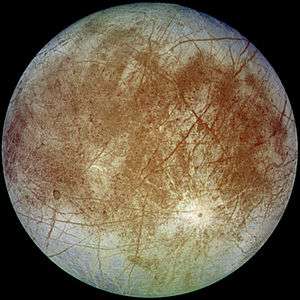 | Jupiter II | |||
| 1650s | |||||
| o: March 25, 1655 p: March 5, 1656 |
Titan | 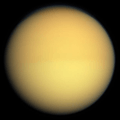 | Saturn VI Saturn II (1673–1684), Saturn IV (1686–1789) |
Huygens[8] first "published" his discovery as an anagram, sent out on 13 June 1655; later published in pamphlet form as De Saturni luna Observatio Nova and in full in Systema Saturnium[9] (July 1659). | |
| 1670s | |||||
| o: October 25, 1671 p: 1673 |
Iapetus | .jpg) | Saturn VIII Saturn III (1673–1684), Saturn V (1686–1789), Saturn VII (1789–1848) |
Cassini[10] | |
| o: December 23, 1672 p: 1673 |
Rhea | 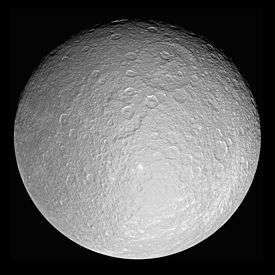 | Saturn V Saturn I (1673–1684), Saturn III (1686–1789) | ||
| 1680s | |||||
| o: March 21, 1684 p: April 22, 1686 |
Tethys |  | Saturn III Saturn I (1686–1789) |
Cassini.[11]
Together with his previous two discoveries, Cassini named these satellites Sidera Lodoicea. In his work Kosmotheôros[12] (published posthumously in 1698), Christiaan Huygens relates "Jupiter you see has his four, and Saturn his five Moons about him, all plac’d in their Orbits." | |
| Dione | 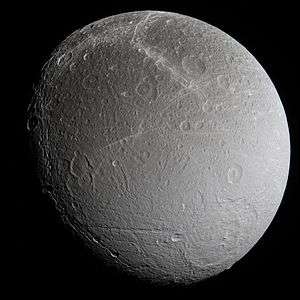 | Saturn IV Saturn II (1686–1789) | |||
| Date | Name | Image | Permanent designation | Discoverer(s) and notes | |
18th century
| 18th century | ||||
|---|---|---|---|---|
| Date | Name | Image | Other/Permanent designation | Discoverer(s) and notes |
| 1780s | ||||
| o: March 13, 1781 p: April 26, 1781 |
Uranus | .jpg) | 7th Planet | Herschel first reported the discovery of Uranus on April 26, 1781, initially believing it to be a comet.[13] |
| o: January 11, 1787 p: February 15, 1787 |
Titania | _color_cropped.jpg) | Uranus III | Herschel.[14][15] He later reported four more spurious satellites.[16] |
| Oberon |  | Uranus IV | ||
| o: August 28, 1789[17] p: November 12, 1789 |
Enceladus |  | Saturn II | Herschel[18] |
| o: September 17, 1789 p: November 12, 1789 |
Mimas | Saturn I | ||
| Date | Name | Image | Other/Permanent designation | Discoverer(s) and notes |
19th century
| 19th century | ||||
|---|---|---|---|---|
| Date | Name | Image | Other/Permanent designation | Discoverer(s) and notes |
| 1800s | ||||
| o: January 1, 1801 p: January 24, 1801 |
Ceres | 8th Planet (1801) Asteroid (1851) Dwarf planet (2006) | Giuseppe Piazzi. He first announced his discovery on January 24, 1801, in letters to fellow astronomers.[19] The first formal publication was the September 1801 issue of the Monatliche Correspondenz.[20] | |
| 1840s | ||||
| o: September 23, 1846 p: November 13, 1846 |
Neptune | .jpg) |
13th Planet (1846) 8th Planet (1851) |
Galle and Le Verrier[21][22] |
| o: October 10, 1846 p: November 13, 1846 |
Triton |  | Neptune I | Lassell[23] |
| o: September 16, 1848 p: October 1848 |
Hyperion | 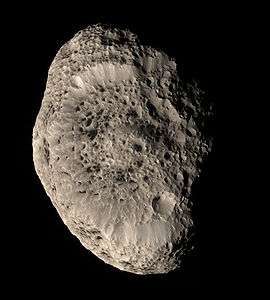 | Saturn VII | Bond, Bond,[24] Lassell[25] |
| 1850s | ||||
| o: October 24, 1851 | Ariel | .jpg) | Uranus I | Lassell[26] |
| Umbriel |  | Uranus II | ||
| 1870s | ||||
| o: August 12, 1877 | Deimos | 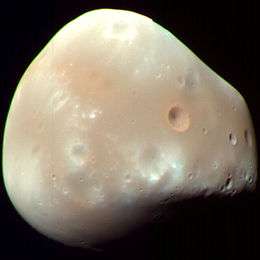 | Mars II | Hall[27][28][29] |
| o: August 18, 1877 | Phobos | | Mars I | |
| 1890s | ||||
| o: September 9, 1892 p: October 4, 1892 |
Amalthea | | Jupiter V | Barnard[1][30] |
| i: August 16, 1898 o: March 17, 1899 |
Phoebe | 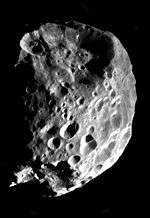 | Saturn IX | Pickering[31][32] |
| Date | Name | Image | Other/Permanent designation | Discoverer(s) and notes |
Early 20th century (1901–1950)
| Early 20th century | ||||
|---|---|---|---|---|
| Date | Name | Image | Permanent designation | Discoverer(s) and notes |
| 1900s | ||||
| i: December 3, 1904 p: January 6, 1905 |
Himalia (Hestia 1955–1975) | | Jupiter VI | Perrine[30][33][34] |
| i: January 2, 1905 p: February 27, 1905 |
Elara (Hera 1955–1975) |  | Jupiter VII | Perrine[30][34][35] |
| i: January 27, 1908 o: February 28, 1908 p: March 1–6, 1908 |
Pasiphae (Poseidon 1955–1975) | | Jupiter VIII | Melotte[30][36][37] |
| 1910s | ||||
| i: July 21, 1914 p: September 17, 1914 |
Sinope (Hades 1955–1975) | 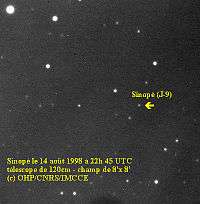 | Jupiter IX | Nicholson[30][38] |
| 1930s | ||||
| i: January 23, 1930 o: February 18, 1930 p: March 13, 1930 |
Pluto |  | 9th Planet (1930) Dwarf planet (2006) | Tombaugh[39] |
| i: July 6, 1938 p: August 1938 |
Lysithea (Demeter 1955–1975) | 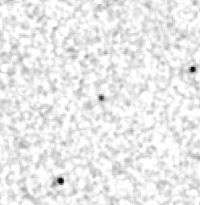 | Jupiter X | Nicholson[30][40] |
| i: July 30, 1938 p: August 1938 |
Carme (Pan 1955–1975) |  | Jupiter XI | |
| 1940s | ||||
| i: February 16, 1948 p: June 1949 |
Miranda |  | Uranus V | Kuiper[30][41] |
| i: May 1, 1949 p: August 1949 |
Nereid |  | Neptune II | Kuiper[30][42][43] |
| Date | Name | Image | Permanent designation | Discoverer(s) and notes |
Late 20th century (1951–2000)
| Late 20th century | |||||
|---|---|---|---|---|---|
| Date | Name | Temporary designation | Image | Permanent designation | Discoverer(s) and notes |
| 1950s | |||||
| i: September 28, 1951 p: December 1951 |
Ananke (Adrastea 1955–1975) | — |  | Jupiter XII | Nicholson[44][45] |
| 1960s | |||||
| i: December 15, 1966 p: January 3, 1967 |
Janus* | S/1966 S 2 |  | Saturn X | Dollfus[44][46][47][48][49] (Dollfus may have seen either Janus or Epimetheus) |
| i: December 18, 1966 p: January 6, 1967 |
Epimetheus* | S/1980 S 3 | 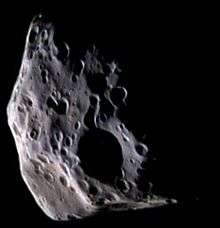 | Saturn XI | Walker[44][50] |
| 1970s | |||||
| i: September 11, 1974 p: September 20, 1974 |
Leda | — | — | Jupiter XIII | Kowal[30][51] |
| i: September 30, 1975 p: October 3, 1975 |
Themisto* | S/1975 J 1 |  | Jupiter XVIII | Kowal[30][52] (Discovered and then lost) |
| i: April 13, 1978 o: June 22, 1978 |
Charon | S/1978 P 1 | .jpg) | Pluto I | Christy[53][54] |
| i: July 8, 1979 p: November 23, 1979 |
Adrastea | S/1979 J 1 | | Jupiter XV | Jewitt, Danielson, Voyager 2[47][55][56][57][58][59] |
| 1980s | |||||
| Date | Name | Temporary designation | Image | Permanent designation | Discoverer(s) and notes |
| i: February 26, 1980 p: March 6, 1980 |
Epimetheus* | S/1980 S 3 |  | Saturn XI | [44][49][60][61][62][63] (Confirmed by Voyager 1) |
| i: March 1, 1980 p: March 6, 1980 |
Helene | S/1980 S 6 | | Saturn XII | Laques, Lecacheux[30][60][61][62][63] |
| i: April 8, 1980 p: April 10, 1980 |
Telesto | S/1980 S 13 | | Saturn XIII | Smith, Reitsema, Larson, Fountain, Voyager 1[44][63][64] |
| i: March 5, 1979 p: April 28, 1980 |
Thebe | S/1979 J 2 |  | Jupiter XIV | Synnott, Voyager 1[44][56][57] |
| i: February 19, 1980 p: June 6, 1980 |
Janus* | S/1980 S 1 |  | Saturn X | [47][49][61][62][63] (Confirmed by Voyager 1) |
| i: March 13, 1980 p: July 31, 1980 |
Calypso | S/1980 S 25 |  | Saturn XIV | Pascu, Seidelmann, Baum, Currie[44][62][63] |
| i:March 4, 1979 p: August 26, 1980 |
Metis | S/1979 J 3 | | Jupiter XVI | Synnott, Voyager 1[44][57] |
| o: October 1980 p: October 31, 1980 |
Prometheus | S/1980 S 27 |  | Saturn XVI | Collins, Voyager 1[65] |
| Pandora | S/1980 S 26 | | Saturn XVII | Collins, Voyager 1[30][65] | |
| o: October 1980 p: November 13, 1980 |
Atlas | S/1980 S 28 |  | Saturn XV | Terrile, Voyager 1[44][66] |
| i: May 24, 1981 p: May 29, 1981 |
Larissa* | S/1981 N 1 S/1989 N 2 | | Neptune VII | Reitsema, Hubbard, Lebofsky, Tholen, Voyager 2[30][67][68] |
| i: December 30, 1985 p: January 9, 1986 |
Puck | S/1985 U 1 |  | Uranus XV | Synnott, Voyager 2[30][69] |
| i: January 3, 1986 p: January 16, 1986 |
Juliet | S/1986 U 2 | | Uranus XI | Synnott, Voyager 2[30][70][71] |
| Portia | S/1986 U 1 | | Uranus XII | ||
| i: January 9, 1986 p: January 16, 1986 |
Cressida | S/1986 U 3 | Uranus IX | ||
| i: January 13, 1986 p: January 16, 1986 |
Desdemona | S/1986 U 6 | | Uranus X | |
| Rosalind | S/1986 U 4 | | Uranus XIII | ||
| Belinda | S/1986 U 5 |  | Uranus XIV | ||
| i: January 20, 1986 p: January 27, 1986 |
Cordelia | S/1986 U 7 | | Uranus VI | Terrile, Voyager 2[30][72] |
| Ophelia | S/1986 U 8 | Uranus VII | |||
| i: January 23, 1986 p: January 27, 1986 |
Bianca | S/1986 U 9 | | Uranus VIII | Smith, Voyager 2[30][72] |
| i: June 16, 1989 p: July 7, 1989 |
Proteus | S/1989 N 1 | .jpg) | Neptune VIII | Synnott, Voyager 2[30][73] |
| i: July 28, 1989 p: August 2, 1989 |
Despina | S/1989 N 3 | | Neptune V | Synnott, Voyager 2[30][68] |
| Galatea | S/1989 N 4 |  | Neptune VI | ||
| i: September 18, 1989 p: September 29, 1989 |
Thalassa | S/1989 N 5 | | Neptune IV | Terrile, Voyager 2[30][74] |
| Naiad | S/1989 N 6 | Neptune III | |||
| 1990s | |||||
| Date | Name | Temporary designation | Image | Permanent designation | Discoverer(s) and notes |
| i: August 22, 1981 p: July 16, 1990 |
Pan* | S/1981 S 13 |  | Saturn XVIII | Showalter, Voyager 2[30][75] |
| i: August 23, 1981 p: April 14, 1995 |
Pallene* (see below) | S/1981 S 14 | | Saturn XXXIII | Gordon, Murray and Beurle[30][76][77] |
| i: September 6, 1997 p: October 31, 1997 |
Caliban | S/1997 U 1 | | Uranus XVI | Gladman, Nicholson, Burns, Kavelaars[30][78] |
| Sycorax | S/1997 U 2 |  | Uranus XVII | Gladman, Nicholson, Burns, Kavelaars[78] | |
| i: January 18, 1986 p: May 18, 1999 | Perdita* | S/1986 U 10 | | Uranus XXV | Karkoschka, Voyager 2[30][79] |
| i: July 18, 1999 p: July 27, 1999 |
Setebos | S/1999 U 1 | — | Uranus XIX | Kavelaars, Gladman, Holman, Petit, Scholl[30][80] |
| Stephano | S/1999 U 2 | — | Uranus XX | Gladman, Holman, Kavelaars, Petit, Scholl[30][80] | |
| i: July 18, 1999 p: September 4, 1999 |
Prospero | S/1999 U 3 |  | Uranus XVIII | Holman, Kavelaars, Gladman, Petit, Scholl[30][81] |
| 2000s | |||||
| Date | Name | Temporary designation | Image | Permanent designation | Discoverer(s) and notes |
| i: October 6, 1999 p: July 20, 2000 |
Callirrhoe | S/1999 J 1 | | Jupiter XVII | Scotti, Spahr, McMillan, Larsen, Montani, Gleason, Gehrels[30][82][83] |
| i: August 7, 2000 p: October 25, 2000 |
Ymir | S/2000 S 1 | — | Saturn XIX | Gladman[30][84][85] |
| Paaliaq | S/2000 S 2 | — | Saturn XX | ||
| i: September 23, 2000 p: October 25, 2000 |
Siarnaq | S/2000 S 3 | — | Saturn XXIX | Gladman, Kavelaars[30][86][87] |
| Tarvos | S/2000 S 4 | | Saturn XXI | Kavelaars, Gladman[30][86][87] | |
| i: August 7, 2000 p: November 18, 2000 |
Kiviuq | S/2000 S 5 | | Saturn XXIV | Gladman[30][87][88] |
| i: September 23, 2000 p: November 18, 2000 |
Ijiraq | S/2000 S 6 | | Saturn XXII | Kavelaars, Gladman[30][87][88] |
| i: November 21, 2000 p: November 25, 2000 |
Themisto* | S/2000 J 1 |  | Jupiter XVIII | Sheppard, Jewitt, Fernández, Magnier (Rediscovered)[30][89][90] |
| i: September 23, 2000 p: December 7, 2000 |
Thrymr | S/2000 S 7 | | Saturn XXX | Gladman, Kavelaars[30][85][91] |
| Skathi | S/2000 S 8 | — | Saturn XXVII | Kavelaars, Gladman[30][85][91] | |
| Mundilfari | S/2000 S 9 |  | Saturn XXV | Gladman, Kavelaars[30][85][91] | |
| Erriapus | S/2000 S 10 | — | Saturn XXVIII | Kavelaars, Gladman[30][87][92] | |
| i: November 9, 2000 p: December 19, 2000 |
Albiorix | S/2000 S 11 | — | Saturn XXVI | Holman, Spahr[30][93][94] |
| i: September 23, 2000 p: December 22, 2000 |
Suttungr | S/2000 S 12 | — | Saturn XXIII | Gladman, Kavelaars[30][95][96] |
| Date | Name | Temporary designation | Image | Permanent designation | Discoverer(s) and notes |
21st century
2000s
| 2000s | |||||
|---|---|---|---|---|---|
| Date | Name | Temporary designation | Image | Permanent designation | Discoverer(s) and notes |
|
i: November 23, 2000 |
Kalyke | S/2000 J 2 | — | Jupiter XXIII | Sheppard, Jewitt, Fernández, Magnier, Dahm, Evans[30][97][98][99] |
| Iocaste | S/2000 J 3 | — | Jupiter XXIV | ||
| Erinome | S/2000 J 4 | — | Jupiter XXV | ||
| Harpalyke | S/2000 J 5 | — | Jupiter XXII | ||
| Isonoe | S/2000 J 6 | — | Jupiter XXVI | ||
| Praxidike | S/2000 J 7 | — | Jupiter XXVII | ||
| i: November 25, 2000 p: January 5, 2001 |
Megaclite | S/2000 J 8 | — | Jupiter XIX | Sheppard, Jewitt, Fernández, Magnier, Dahm, Evans[30][97][99] |
| Taygete | S/2000 J 9 | — | Jupiter XX | ||
| i: November 26, 2000 p: January 5, 2001 |
Chaldene | S/2000 J 10 | — | Jupiter XXI | |
| i: December 5, 2000 p: January 5, 2001 |
Dia | S/2000 J 11 | — | Jupiter LIII | |
| Date | Name | Temporary designation | Image | Permanent designation | Discoverer(s) and notes |
| i: December 9, 2001 p: May 16, 2002 |
Hermippe | S/2001 J 3 | | Jupiter XXX | Sheppard, Jewitt, Kleyna[30][100][101] |
| Eurydome | S/2001 J 4 | — | Jupiter XXXII | ||
| Sponde | S/2001 J 5 | — | Jupiter XXXVI | ||
| Kale | S/2001 J 8 | — | Jupiter XXXVII | ||
| i: December 10, 2001 p: May 16, 2002 |
Autonoe | S/2001 J 1 | — | Jupiter XXVIII | |
| i: December 11, 2001 p: May 16, 2002 |
Thyone | S/2001 J 2 | — | Jupiter XXIX | |
| Pasithee | S/2001 J 6 | — | Jupiter XXXVIII | ||
| Euanthe | S/2001 J 7 | — | Jupiter XXXIII | ||
| Orthosie | S/2001 J 9 | — | Jupiter XXXV | ||
| Euporie | S/2001 J 10 | — | Jupiter XXXIV | ||
| Aitne | S/2001 J 11 | — | Jupiter XXXI | ||
| i: August 13, 2001 p: September 30, 2002 |
Trinculo | S/2001 U 1 | — | Uranus XXI | Holman, Kavelaars, Milisavljevic[30][102][103] |
| i: October 31, 2002 p: December 18, 2002 |
Arche | S/2002 J 1 | — | Jupiter XLIII | Sheppard, Meech, Hsieh, Tholen, Tonry[30][104][105] |
| Date | Name | Temporary designation | Image | Permanent designation | Discoverer(s) and notes |
| i: July 23, 2002 p: January 13, 2003 |
Sao | S/2002 N 2 | — | Neptune XI | Holman, Kavelaars, Grav, Fraser, Milisavljevic[30][106][107] |
| i: August 10, 2002 p: January 13, 2003 |
Halimede | S/2002 N 1 | — | Neptune IX | |
| i: August 11, 2002 p: January 13, 2003 |
Laomedeia | S/2002 N 3 | — | Neptune XII | |
| i: February 5, 2003 p: March 4, 2003 |
Eukelade | S/2003 J 1 | — | Jupiter XLVII | Sheppard, Jewitt, Kleyna, Fernández, Hsieh[30][108][109] |
| (unnamed moons of Jupiter) | S/2003 J 2 | — | — | ||
| S/2003 J 3 | — | ||||
| S/2003 J 4 | — | ||||
| i: February 6, 2003 p: March 4, 2003 |
(unnamed moon of Jupiter) | S/2003 J 5 | — | — | |
| Helike | S/2003 J 6 | — | Jupiter XLV | ||
| i: February 8, 2003 p: March 4, 2003 |
Aoede | S/2003 J 7 | — | Jupiter XLI | |
| i: February 8, 2003 p: March 6, 2003 |
Hegemone | S/2003 J 8 | — | Jupiter XXXIX | Sheppard, Jewitt, Kleyna, Fernández[30][110][111] |
| i: February 6, 2003 p: March 7, 2003 |
(unnamed moons of Jupiter) | S/2003 J 9 | — | — | Sheppard, Jewitt, Kleyna, Fernández[30][112][113] |
| S/2003 J 10 | — | ||||
| Kallichore | S/2003 J 11 | — | Jupiter XLIV | ||
| i: February 8, 2003 p: March 7, 2003 |
(unnamed moon of Jupiter) | S/2003 J 12 | — | — | |
| i: February 9, 2003 p: April 2, 2003 |
Cyllene | S/2003 J 13 | — | Jupiter XLVIII | Sheppard, Jewitt, Kleyna[30][114][115] |
| i: February 8, 2003 p: April 3, 2003 |
Kore | S/2003 J 14 | — | Jupiter XLIX | Sheppard, Jewitt, Kleyna[30][114][116] |
| i: February 6, 2003 p: April 3, 2003 |
(unnamed moons of Jupiter) | S/2003 J 15 | — | — | Sheppard, Jewitt, Kleyna, Fernández[114][117] |
| S/2003 J 16 | — | Gladman, Sheppard, Jewitt, Kleyna, Kavelaars, Petit, Allen[114][118] | |||
| i: February 8, 2003 p: April 3, 2003 |
Herse | S/2003 J 17 | — | Jupiter L | Gladman, Sheppard, Jewitt, Kleyna, Kavelaars, Petit, Allen[30][114][119] |
| i: February 6, 2003 p: April 4, 2003 |
(unnamed moon of Jupiter) | S/2003 J 18 | — | — | Gladman, Kavelaars, Petit, Allen, Sheppard, Jewitt, Kleyna[30][114][120] |
| i: February 5, 2003 p: April 8, 2003 |
Narvi | S/2003 S 1 | — | Saturn XXXI | Sheppard, Jewitt, Kleyna[30][114][121] |
| i: February 6, 2003 p: April 12, 2003 |
(unnamed moon of Jupiter) | S/2003 J 19 | — | — | Gladman, Sheppard, Jewitt, Kleyna, Kavelaars, Petit, Allen[122][123] |
| i: February 9, 2003 p: April 14, 2003 |
Carpo | S/2003 J 20 | — | Jupiter XLVI | Sheppard, Gladman, Kavelaars, Petit, Allen, Jewitt, Kleyna[30][122][124] |
| i: February 6, 2003 p: May 29, 2003 |
Mneme | S/2003 J 21 | — | Jupiter XL | Sheppard, Jewitt, Kleyna, Gladman, Kavelaars, Petit, Allen[30][125][126] |
| i: January 18, 1986 p: September 3, 2003 |
Perdita* | S/1986 U 10 | — | Uranus XXV | Karkoschka (Recovered by the Hubble Space Telescope)[30][79][127] |
| i: August 29, 2003 p: September 3, 2003 |
Psamathe | S/2003 N 1 | — | Neptune X | Jewitt, Kleyna, Sheppard, Holman, Kavelaars[30][128][129] |
| i: August 25, 2003 p: September 25, 2003 |
Mab | S/2003 U 1 | — | Uranus XXVI | Showalter, Lissauer[130] |
| Cupid | S/2003 U 2 | — | Uranus XXVII | ||
| i: August 13, 2001 p: September 30, 2003 |
Ferdinand* | S/2001 U 2 | — | Uranus XXIV | 2001: Holman, Kavelaars, Milisavljevic; 2003: Sheppard, Jewitt[30][131][132] |
| i: August 14, 2002 p: September 30, 2003 |
Neso* | S/2002 N 4 | — | Neptune XIII | Holman, Kavelaars, Grav, Fraser, Milisavljevic[30][131][133] |
| i: August 13, 2001 p: October 8, 2003 |
Francisco* | S/2001 U 3 | | Uranus XXII | Holman, Kavelaars, Milisavljevic, Gladman[30][134] |
| i: August 29, 2003 p: October 9, 2003 |
Margaret | S/2003 U 3 | — | Uranus XXIII | Sheppard, Jewitt[30][135][136] |
| Date | Name | Temporary designation | Image | Permanent designation | Discoverer(s) and notes |
| i: February 9, 2003 p: January 24, 2004 |
Thelxinoe* | S/2003 J 22 | — | Jupiter XLII | Sheppard, Jewitt, Kleyna, Gladman, Kavelaars, Petit, Allen[30][137][138] (From images taken in 2003) |
| i: February 6, 2003 p: January 31, 2004 |
(unnamed moon of Jupiter) | S/2003 J 23* | | — | Sheppard, Jewitt, Kleyna, Fernández[139][140] |
| i: June 1, 2004 p: August 16, 2004 |
Methone* | S/2004 S 1 | | Saturn XXXII | Cassini–Huygens[30][141][142] |
| Pallene | S/2004 S 2 =S/1981 S 14 | | Saturn XXXIII | ||
| i: October 21, 2004 o: October 24, 2004 p: November 8, 2004 |
Polydeuces | S/2004 S 5 | | Saturn XXXIV | Cassini–Huygens[30][143] |
| i: May 6, 2004 o: December 28, 2004 p: July 29, 2005 |
Haumea | (136108) 2003 EL61 | — | Dwarf planet | (Ortiz, Aceituno Castro, Santos-Sanz)[30][144] or (Brown, Trujillo, Rabinowitz)[145][146] (see the Controversy over the discovery of Haumea) |
| Date | Name | Temporary designation | Image | Permanent designation | Discoverer(s) and notes |
| i: December 12, 2004 p: May 3, 2005 |
(unnamed moon of Saturn) | S/2004 S 7 | — | — | Sheppard, Jewitt, Kleyna, Marsden[30][147] |
| Fornjot | S/2004 S 8 |  | Saturn XLII | ||
| Farbauti | S/2004 S 9 | — | Saturn XL | ||
| Aegir | S/2004 S 10 | — | Saturn XXXVI | ||
| Bebhionn | S/2004 S 11 | | Saturn XXXVII | ||
| (unnamed moons of Saturn) | S/2004 S 12 | — | — | ||
| S/2004 S 13 | |||||
| Hati | S/2004 S 14 | — | Saturn XLIII | ||
| Bergelmir | S/2004 S 15 |  | Saturn XXXVIII | ||
| i: December 13, 2004 p: May 3, 2005 |
Fenrir | S/2004 S 16 | — | Saturn XLI | |
| (unnamed moon of Saturn) | S/2004 S 17 | — | — | ||
| Bestla | S/2004 S 18 | — | Saturn XXXIX | ||
| i: May 1, 2005 p: May 6, 2005 |
Daphnis | S/2005 S 1 |  | Saturn XXXV | Cassini–Huygens[148] |
| i: October 21, 2003 o: January 5, 2005 p: July 29, 2005 |
Eris | (136199) 2003 UB313 |  | Dwarf planet | Brown, Trujillo, Rabinowitz[30][145][149] |
| o: January 26, 2005 p: July 29, 2005 |
Hiʻiaka | S/2005 (136108) 1 | — | Haumea I | Brown, Trujillo, Rabinowitz[30][150] |
| i: March 31, 2005 p: July 29, 2005 |
Makemake | (136472) 2005 FY9 | — | Dwarf planet | Brown, Trujillo, Rabinowitz[145][151] |
| o: June 30, 2005 p: July 29, 2005 |
Namaka | S/2005 (136108) 2 | — | Haumea II | Brown, Trujillo, Rabinowitz[152] |
| i: September 10, 2005 p: October 3, 2005 |
Dysnomia | S/2005 (136199) 1 |  | Eris I | Brown, van Dam, Bouchez, Le Mignant, Campbell, Chin, Conrad, Hartman, Johansson, Lafon, Rabinowitz, Stomski, Summers, Trujillo, Wizinowich[153] |
| i: May 15, 2005 o: June 15, 2005 p: October 31, 2005 |
Nix | S/2005 P 2 | | Pluto II | Weaver, Stern, Mutchler, Steffl, Buie, Merline, Spencer, Young, Young[154] |
| Hydra | S/2005 P 1 | Pluto III | |||
| Date | Name | Temporary designation | Image | Permanent designation | Discoverer(s) and notes |
| i: December 12, 2004 o: March 6, 2006 (?) p: June 26, 2006 |
Hyrrokkin | S/2004 S 19 | — | Saturn XLIV | Sheppard, Jewitt, Kleyna[30][155][156] |
| i: January 4, 2006 o: March 6, 2006 (?) p: June 26, 2006 |
(unnamed moon of Saturn) | S/2006 S 1 | — | — | Sheppard, Jewitt, Kleyna[30][156][157] |
| Kari | S/2006 S 2 | | Saturn XLV | ||
| i: January 5, 2006 o: March 6, 2006 (?) p: June 26, 2006 |
(unnamed moon of Saturn) | S/2006 S 3 | — | — | |
| Greip | S/2006 S 4 | — | Saturn LI | ||
| Loge | S/2006 S 5 | — | Saturn XLVI | ||
| Jarnsaxa | S/2006 S 6 | — | Saturn L | ||
| Surtur | S/2006 S 7 | — | Saturn XLVIII | ||
| Skoll | S/2006 S 8 | — | Saturn XLVII | ||
| i: January 5, 2006 o: January 16, 2007 (?) p: April 13, 2007 |
Tarqeq | S/2007 S 1 | — | Saturn LII | Sheppard, Jewitt, Kleyna[30][158][159] |
| i: January 18, 2007 o: ? p: May 1, 2007 |
(unnamed moons of Saturn) | S/2007 S 2 | — | — | Sheppard, Jewitt, Kleyna[159][160] |
| S/2007 S 3 | — | — | |||
| i: June 2004 o: May 30, 2007 p: July 18, 2007 | Anthe | S/2007 S 4 | | Saturn XLIX | Cassini–Huygens[30][161] |
| i: August 15, 2008 p: March 3, 2009 | Aegaeon | S/2008 S 1 | | Saturn LIII | Cassini–Huygens[30][162] |
| i: July 26, 2009 o: ? p: November 2, 2009 | (unnamed moon of Saturn) | S/2009 S 1 | | — | Cassini–Huygens[163] |
| Date | Name | Temporary designation | Image | Permanent designation | Discoverer(s) and notes |
2010s
| 2010s | |||||
|---|---|---|---|---|---|
| Date | Name | Temporary designation | Image | Permanent designation | Discoverer(s) and notes |
|
i: September 7, 2010 |
(unnamed moons of Jupiter) | S/2010 J 1 | — | Jupiter LI | Jacobson, Brozović, Gladman and Alexandersen[164] |
| S/2010 J 2 | — | Jupiter LII | Veillet[164] | ||
|
i: June 28, 2011 |
Kerberos | S/2011 (134340) 1 | | Pluto IV | Showalter[165][166] |
|
i: September 27, 2011 |
(unnamed moons of Jupiter) | S/2011 J 1 | — | — | Sheppard[167] |
| S/2011 J 2 | — | — | |||
|
i: June 26, 2012 |
Styx | S/2012 (134340) 1 |  | Pluto V | Showalter[168] |
|
i: 2004 |
(unnamed moon of Neptune) | S/2004 N 1* | | — | Showalter et al.[169] |
|
i: April 2015 |
(unnamed moon of Makemake) | S/2015 (136472) 1 | — | — | Parker et al.[170][171] |
| Date | Name | Temporary designation | Image | Permanent designation | Discoverer(s) and notes |
See also
References
- 1 2 Barnard, Edward Emerson (1892-10-04). "Discovery and observations of a fifth satellite to Jupiter". Astronomical Journal. 12 (11): 81–85. Bibcode:1892AJ.....12...81B. doi:10.1086/101715.
- ↑ Nicholson, Seth Barnes (April 1939). "The Satellites of Jupiter". Publications of the Astronomical Society of the Pacific. 51 (300): 85–94. Bibcode:1939PASP...51...85N. doi:10.1086/125010.
- ↑ Stanford SOLAR Center - Ask A Solar Physicist FAQs - Answer
- ↑ Sachs, Abraham J. (2 May 1974). "Babylonian Observational Astronomy". Philosophical Transactions of the Royal Society of London. Royal Society of London. 276 (1257): 43–50 [45 & 48–9]. Bibcode:1974RSPTA.276...43S. doi:10.1098/rsta.1974.0008. JSTOR 74273.
- ↑ Galilei, Galileo; Sidereus Nuncius, Thomam Baglionum (Tommaso Baglioni), Venice (March 1610), pp. 17–28 (q.v.)
- ↑ Drake, Stillman (1981). Galileo at Work. Courier Dover Publications. p. 153. ISBN 978-0-486-49542-2.
- ↑ Blue, Jennifer (9 November 2009). "Planet and Satellite Names and Discoverers". USGS. Retrieved 13 January 2010.
- ↑ Huygens, Christiaan; De Saturni luna observatio nova, Adriaan Vlacq, Den Haag, 5 March 1656 (click "Scientific work")
- ↑ Hugenii, Cristiani (Christiaan Huygens); Systema Saturnium, Adriani Vlacq, Hagæ-Comitis (The Hague), 1659 (p. 47)
- ↑ Cassini, Giovanni D.; Découverte de deux nouvelles planètes autour de Saturne, Sébastien Mabre-Cramoisy, Paris, 1673. Translated as A Discovery of two New Planets about Saturn, made in the Royal Parisian Observatory by Signor Cassini, Fellow of both the Royal Societys, of England and France; English't out of French., Philosophical Transactions, Vol. 8 (1673), pp. 5178–5185
- ↑ Cassini published these two discoveries on April 22, 1686, according to An Extract of the Journal Des Scavans. of April 22 st. N. 1686. Giving an account of two new Satellites of Saturn, discovered lately by Mr. Cassini at the Royal Observatory at Paris., Philosophical Transactions, Vol. 16 (1686–1692), pp. 79–85
- ↑ Hugenii, Christiani (Christiaan Huygens); Κοσμοθεωρος (Kosmotheôros), Adrianum (Adriaan) Moetjens, Hagæ-Comitum (The Hague), 1698
- ↑ Herschel, William; Account of a Comet. By Mr. Herschel, F. R. S.; communicated by Dr. Watson, Jun. of Bath, F. R. S., Philosophical Transactions of the Royal Society of London, Vol. 71, pp. 492–501
- ↑ Herschel, W. S. (1787). "An Account of the Discovery of Two Satellites Revolving Round the Georgian Planet". Philosophical Transactions of the Royal Society of London. 77: 125–129. doi:10.1098/rstl.1787.0016. JSTOR 106717.
- ↑ Herschel, William; On George's Planet and its satellites, Philosophical Transactions of the Royal Society of London, Vol. 78, pp. 364–378, 1788
- ↑ Herschel, William; On the Discovery of Four Additional Satellites of the Georgium Sidus. The Retrograde Motion of Its Old Satellites Announced; And the Cause of Their Disappearance at Certain Distances from the Planet Explained, Philosophical Transactions of the Royal Society of London, Vol. 88, pp. 47–79, 1798
- ↑ Jodra, Serge; Les Satellites de Saturne (2004)
- ↑ Herschel, William; Account of the Discovery of a Sixth and Seventh Satellite of the Planet Saturn; with Remarks on the Construction of its Ring, its Atmosphere, its Rotation on an Axis, and its spheroidical Figure, Philosophical Transactions of the Royal Society of London, Vol. 80, pp. 1–20, 1790 (read 12 November 1789)
- ↑ Hoskin, Michael (26 June 1992). "Bodes' Law and the Discovery of Ceres". Observatorio Astronomico di Palermo "Giuseppe S. Vaiana". Retrieved 5 July 2007.
- ↑ Forbes, Eric G. (1971). "Gauss and the Discovery of Ceres". Journal for the History of Astronomy. 2: 195–199. Bibcode:1971JHA.....2..195F.
- ↑ Airy, George Biddell; Account of some circumstances historically connected with the discovery of the Planet exterior to Uranus, Monthly Notices of the Royal Astronomical Society, Vol. 7, No. 9 (13 November 1846), pp. 121–152
- ↑ Account of the Discovery of the Planet of Le Verrier at Berlin, Monthly Notices of the Royal Astronomical Society, Vol. 7, No. 9 (13 November 1846), pp. 153–157
- ↑ Lassell, William; Monthly Notices of the Royal Astronomical Society, Vol. 7, No. 9 (13 November 1846), reported in Account of the Discovery of the Planet of Le Verrier at Berlin, ibid., pp. 153–157
- ↑ Bond, William C.; Discovery of a new Satellite of Saturn, Monthly Notices of the Royal Astronomical Society, Vol. 9, No. 1 (10 November 1848), pp. 1–2
- ↑ Lassell, W.; Discovery of a new Satellite of Saturn, Monthly Notices of the Royal Astronomical Society, Vol. 8 No. 9 Supplement (undated, some time after 24 September 1848), pp. 195–197
- ↑ Lassell, W.; Letter from William Lassell, Esq., to the Editor, Astronomical Journal, Vol. 2, No. 33 (1851), p. 70 (signed 11 November 1851)
- ↑ Christie, William H. M.; The Satellites of Mars, The Observatory, Vol. 1, No. 6 (20 September 1877), pp. 181–185
- ↑ Hall, Asaph; Observations of the Satellites of Mars (signed 21 September 1877), Astronomische Nachrichten, Vol. 91, No. 2161 (17 October 1877), pp. 11/12–13/14
- ↑ Hall, Asaph; The Discovery of the Satellites of Mars (signed 28 December 1877), Monthly Notices of the Royal Astronomical Society, Vol. 38, No. 4 (8 February 1878), pp. 205–209
- 1 2 3 4 5 6 7 8 9 10 11 12 13 14 15 16 17 18 19 20 21 22 23 24 25 26 27 28 29 30 31 32 33 34 35 36 37 38 39 40 41 42 43 44 45 46 47 48 49 50 51 52 53 54 55 56 57 58 59 60 61 62 63 64 65 66 67 68 69 70 71 72 73 74 Gazetteer of Planetary Nomenclature: Planet and Satellite Names and Discoverers
- ↑ Pickering, Edward C.; A New Satellite of Saturn, Harvard College Observatory Bulletin, No. 49 (17 March 1899), p. 1
- ↑ Pickering, Edward C.; A New Satellite of Saturn (signed 10 April 1899), Astrophysical Journal, Vol. 9, No. 4 (April 1899), pp. 274–276
- ↑ Campbell, William W.; Sixth Satellite of Jupiter, Harvard College Observatory Bulletin, No. 173 (6 January 1905), p. 1
- Perrine, Charles D.; Discovery of a Sixth Satellite to Jupiter (signed 30 January 1905), Publications of the Astronomical Society of the Pacific, Vol. 17, No. 100 (10 February 1905), pp. 22–23
- Aitken, Robert G.; Visual Observation of Satellite VI to Jupiter (signed 30 January 1905), Publications of the Astronomical Society of the Pacific, Vol. 17, No. 100 (10 February 1905), pp. 23–24
- Discovery of a Sixth Satellite of Jupiter, Astronomical Journal, Vol. 24, No. 19 (whole No. 571, 28 March 1905), p. 160
- 1 2 Perrine, Charles D.; Orbits of the sixth and seventh satellites of Jupiter (signed 28 May 1905), Astronomische Nachrichten, Vol. 169, No. 4035 (24 July 1905), p. 43/44
- ↑ Campbell, William W.; A Seventh Satellite of Jupiter, Harvard College Observatory Bulletin, No. 178 (27 February 1905), p. 1
- The Seventh Satellite of Jupiter (signed 30 March 1905), Publications of the Astronomical Society of the Pacific, Vol. 17, No. 101 (10 April 1905), pp. 56–57
- ↑ Perrine, Charles D.; Recent Observations of the Moving Object near Jupiter, Discovered at Greenwich by Mr. J. Melotte (signed 21 May 1908), Publications of the Astronomical Society of the Pacific, Vol. 20, No. 120 (10 June 1908), p. 184
- ↑ Cowell, Philip H.; Note on the discovery of a Moving Object near Jupiter (1908 CJ), Monthly Notices of the Royal Astronomical Society, Vol. 68, No. 5 (13 March 1908), p. 373
- ↑ Nicholson, Seth B.; Discovery of the Ninth Satellite of Jupiter (signed 17 September 1914), Publications of the Astronomical Society of the Pacific, Vol. 26, No. 155 (October 1914), pp. 197–198
- ↑ Tombaugh, Clyde W.; The Search for the Ninth Planet, Pluto, Astronomical Society of the Pacific Leaflets, Vol. 5, No. 209 (July 1946), pp. 73–80
- ↑ Nicholson, Seth B.; Two New Satellites of Jupiter (signed August 1938), Publications of the Astronomical Society of the Pacific, Vol. 50, No. 297 (October 1938), pp. 292–293
- ↑ Kuiper, Gerard P.; The Fifth Satellite of Uranus, Publications of the Astronomical Society of the Pacific, Vol. 61, No. 360 (June 1949), p. 129
- ↑ Kuiper, Gerard P.; The Second Satellite of Neptune, Publications of the Astronomical Society of the Pacific, Vol. 61, No. 361 (August 1949), pp. 175–176
- ↑ Vinter Hansen, Julie M.; Object Near Neptune, IAUC 1212 (1 April 1949)
- 1 2 3 4 5 6 7 8 9 Marsden, Brian G.; GX 1+4; Sats OF JUPITER AND SATURN, IAUC 3872 (30 March 1983)
- ↑ Nicholson, Seth B.; An Unidentified Object Near Jupiter, Probably a New Satellite, Publications of the Astronomical Society of the Pacific, Vol. 63, No. 375 (December 1951), pp. 297–299
- ↑ Gingerich, Owen; Probable New Satellite of Saturn, IAUC 1987 (3 January 1967)
- Gingerich, Owen; Saturn X (Janus), IAUC 1995 (1 February 1967)
- Marsden, Brian G.; New Ring and Satellites of Saturn, IAUC 3417 (25 October 1979)
- 1 2 3 Marsden, Brian G.; Saturn, IAUC 3454 (25 February 1980)
- ↑ Marsden, Brian G.; 1980 S 2, IAUC 3456 (29 February 1980)
- 1 2 3 Marsden, Brian G.; Saturn, IAUC 3497 (4 August 1980)
- ↑ Gingerich, Owen; Possible New Satellite of Saturn, IAUC 1991 (6 January 1967)
- ↑ Kowal, Charles T.; Thirteenth satellite of Jupiter, Astronomical Journal, Vol. 80, No. 6 (June 1975), pp. 460–464
- Marsden, Brian G.; Probable New Satellite of Jupiter, IAUC 2702 (20 September 1974)
- Marsden, Brian G.; Probable New Satellite of Jupiter, IAUC 2703 (1 October 1974)
- Marsden, Brian G.; Jupiter XIII, IAUC 2711 (24 October 1974)
- ↑ Marsden, Brian G.; Probable New Satellite of Jupiter, IAUC 2845 (3 October 1975)
- Marsden, Brian G.; Probable New Satellite of Jupiter, IAUC 2855 (23 October 1975)
- Marsden, Brian G.; Probable New Satellite of Jupiter, IAUC 2899 (9 January 1976)
- ↑ Marsden, Brian G.; 1978 P 1, IAUC 3241 (7 July 1978)
- ↑ Christy, James W.; Harrington, Robert S.; The satellite of Pluto, Astronomical Journal, Vol. 83, No. 8 (August 1978), pp. 1005–1008
- ↑ Jewitt, David C., Danielson, G. Edward, Synnott, Stephen P.; Discovery of a new Jupiter satellite, Science, Vol. 206, No. 4421 (23 November 1979), p. 951
- 1 2 Marsden, Brian G.; Satellites of Jupiter, IAUC 3470 (28 April 1980)
- 1 2 3 Marsden, Brian G.; Satellites of Jupiter, IAUC 3507 (26 August 1980)
- ↑ Hamilton, Calvin J.; Discovery Image of Adrastea, Views of the Solar System (1995–2007)
- ↑ Jovian System Data Analysis Program; Voyager 2 Jupiter Image 20630.53, NASA Planetary Data System Rings Node (20 February 1997)
- 1 2 Marsden, Brian G.; Saturn, IAUC 3457 (6 March 1980)
- 1 2 3 Marsden, Brian G.; Satellites of Saturn, IAUC 3483 (6 June 1980)
- 1 2 3 4 Marsden, Brian G.; Satellites of Saturn, IAUC 3496 (31 July 1980)
- 1 2 3 4 5 Marsden, Brian G.; Satellites of Saturn, IAUC 3534 (7 November 1980)
- ↑ Marsden, Brian G.; Satellites of Saturn, IAUC 3466 (10 April 1980)
- 1 2 Marsden, Brian G.; Satellites of Saturn, IAUC 3532 (31 October 1980)
- ↑ Marsden, Brian G.; 1980 S 28, IAUC 3539 (13 November 1980)
- ↑ Marsden, Brian G.; 1981 N 1, IAUC 3608 (29 May 1981)
- 1 2 Marsden, Brian G.; Satellites of Neptune, IAUC 4824 (2 August 1989)
- ↑ Marsden, Brian G.; Satellites of Uranus and Neptune, IAUC 4159 (9 January 1986)
- ↑ Marsden, Brian G.; Satellites of Uranus, IAUC 4164 (16 January 1986)
- ↑ Marsden, Brian G.; Satellites of Uranus, IAUC 4165 (17 January 1986)
- 1 2 Marsden, Brian G.; Satellites and Rings of Uranus, IAUC 4168 (27 January 1986)
- ↑ Marsden, Brian G.; 1989 N 1, IAUC 4806 (7 July 1989)
- ↑ Marsden, Brian G.; Neptune, IAUC 4867 (29 September 1989)
- ↑ Green, Daniel W. E.; Saturn, IAUC 5052 (16 July 1990)
- ↑ Green, Daniel W. E.; Possible Satellites of Saturn, IAUC 6162 (14 April 1995)
- ↑ Gordon, Mitchell K.; Murray, Carl D.; and Beurle, Kevin; Further Evidence for the Existence of Additional Small Satellites of Saturn, Icarus, Vol. 121, No. 1 (May 1996), pp. 114–125
- 1 2 Marsden, Brian G.; Satellites of Uranus, IAUC 6764 (31 October 1997)
- 1 2 Green, Daniel W. E.; S/1986 U 10, IAUC 7171 (18 May 1999)
- 1 2 Marsden, Brian G.; Probable New Satellites of Uranus, IAUC 7230 (27 July 1999)
- ↑ Marsden, Brian G.; Probable New Satellites of Uranus, IAUC 7248 (4 September 1999)
- ↑ Marsden, Brian G.; S/1999 J 1, IAUC 7460 (20 July 2000)
- ↑ New Outer Satellite of Jupiter Discovered, Joint press release, Minor Planet Center and the Spacewatch Project (2000?)
- ↑ Marsden, Brian G.; S/2000 S 1 and S/2000 S 2, IAUC 7512 (25 October 2000)
- 1 2 3 4 Marsden, Brian G.; S/2000 S 1, S/2000 S 2, S/2000 S 7, S/2000 S 8, S/2000 S 9, MPEC 2000-Y15 (19 December 2000)
- 1 2 Marsden, Brian G.; S/2000 S 3 and S/2000 S 4, IAUC 7513 (25 October 2000)
- 1 2 3 4 5 Marsden, Brian G.; S/2000 S 3, S/2000 S 4, S/2000 S 5, S/2000 S 6, S/2000 S 10, MPEC 2000-Y14 (19 December 2000)
- 1 2 Marsden, Brian G.; S/2000 S 5 and S/2000 S 6, IAUC 7521 (18 November 2000)
- ↑ Marsden, Brian G.; S/1975 J 1 = S/2000 J 1, IAUC 7525 (25 November 2000)
- ↑ S/1975 J 1 = S/2000 J 1, S/1999 J 1, MPEC 2000-Y16 (19 December 2000)
- 1 2 3 Marsden, Brian G.; S/2000 S 7, S/2000 S 8, S/2000 S 9, IAUC 7538 (7 December 2000)
- ↑ Marsden, Brian G.; S/2000 S 10, IAUC 7539 (7 December 2000)
- ↑ Green, Daniel W. E.; S/2000 S 11, IAUC 7545 (19 December 2000)
- ↑ Marsden, Brian G.; S/2000 S 11, MPEC 2000-Y13 (19 December 2000)
- ↑ Marsden, Brian G.; S/2000 S 12, IAUC 7548 (23 December 2000)
- ↑ Marsden, Brian G.; S/2000 S 12, MPEC 2000-Y33 (22 December 2000)
- 1 2 Green, Daniel W. E.; Satellites of Jupiter, IAUC 7555 (5 January 2001)
- ↑ Marsden, Brian G.; S/2000 J 2, S/2000 J 3, S/2000 J 4, S/2000 J 5, S/2000 J 6, MPEC 2001-A28 (5 January 2001)
- 1 2 Marsden, Brian G.; S/2000 J 7, S/2000 J 8, S/2000 J 9, S/2000 J 10, S/2000 J 11, MPEC 2001-A29 (5 January 2001)
- ↑ Green, Daniel W. E.; Satellites of Jupiter, IAUC 7900 (16 May 2002)
- ↑ Marsden, Brian G.; Eleven New Satellites of Jupiter, MPEC 2002-J54 (15 May 2002)
- ↑ Green, Daniel W. E.; S/2001 U 1, IAUC 7980 (30 September 2002)
- ↑ Marsden, Brian G.; S/2001 U 1, MPEC 2002-S64 (30 September 2002)
- ↑ Green, Daniel W. E.; S/2002 J 1, IAUC 8035 (18 December 2002)
- ↑ Marsden, Brian G.; S/2002 J 1, MPEC 2002-Y22 (18 December 2002)
- ↑ Green, Daniel W. E.; Satellites of Neptune, IAUC 8047 (13 January 2003)
- ↑ Marsden, Brian G.; S/2002 N 1, 2002 N 2, 2002 N3, MPEC 2003-A75 (13 January 2003)
- ↑ Green, Daniel W. E.; Satellites of Jupiter, IAUC 8087 (4 March 2003)
- ↑ Marsden, Brian G.; S/2003 J 1, 2003 J 2, 2003 J 3, 2003 J 4, 2003 J 5, 2003 J 6, 2003 J 7, MPEC 2003-E11 (4 March 2003)
- ↑ Green, Daniel W. E.; S/2003 J 8, IAUC 8088 (6 March 2003)
- ↑ Marsden, Brian G.; S/2003 J 8, MPEC 2003-E15 (6 March 2003)
- ↑ Green, Daniel W. E.; Satellites of Jupiter, IAUC 8089 (7 March 2003)
- ↑ Marsden, Brian G.; S/2003 J 9, 2003 J 10, 2003 J 11, 2003 J 12; S/2003 J 1, 2003 J 6, MPEC 2003-E29 (7 March 2003)
- 1 2 3 4 5 6 7 Green, Daniel W. E.; Satellites of Jupiter and Saturn, IAUC 8116 (11 April 2003)
- ↑ Marsden, Brian G.; S/2003 J 13, MPEC 2003-G09 (2 April 2003)
- ↑ Marsden, Brian G.; S/2003 J 14, MPEC 2003-G10 (3 April 2003)
- ↑ Marsden, Brian G.; S/2003 J 15, MPEC 2003-G17 (3 April 2003)
- ↑ Marsden, Brian G.; S/2003 J 16, MPEC 2003-G18 (3 April 2003)
- ↑ Marsden, Brian G.; S/2003 J 17, MPEC 2003-G19 (3 April 2003)
- ↑ Marsden, Brian G.; S/2003 J 18, MPEC 2003-G20 (4 April 2003)
- ↑ Marsden, Brian G.; S/2003 S 1, MPEC 2003-G39 (8 April 2003)
- 1 2 Green, Daniel W. E.; S/2003 J 19 and S/2003 J 20, IAUC 8125 (30 April 2003)
- ↑ Marsden, Brian G.; S/2003 J 19, MPEC 2003-G64 (12 April 2003)
- ↑ Marsden, Brian G.; S/2003 J 20, MPEC 2003-G67 (14 April 2003)
- ↑ Green, Daniel W. E.; S/2003 J 21, IAUC 8138 (30 May 2003)
- ↑ Marsden, Brian G.; S/2003 J 21, MPEC 2003-K45 (29 May 2003)
- ↑ Green, Daniel W. E.; Satellites of Uranus, IAUC (3 September 2003)
- ↑ Green, Daniel W. E.; Satellites of Neptune, IAUC 8193 (3 September 2003)
- ↑ Marsden, Brian G.; S/2003 N 1, MPEC 2003-G64 (3 September 2003)
- ↑ Green, Daniel W. E.; S/2003 U 1 and S/2003 U 2, IAUC 8209 (25 September 2003)
- 1 2 Green, Daniel W. E.; S/2001 U 2 and S/2002 N 4, IAUC 8213 (1 October 2003)
- ↑ Marsden, Brian G.; S/2001 U 2, MPEC 2003-S105 (30 September 2003)
- ↑ Marsden, Brian G.; S/2002 N 4, MPEC 2003-S107 (30 September 2003)
- ↑ Green, Daniel W. E.; S/2001 U 3, IAUC 8216 (8 October 2003)
- ↑ Green, Daniel W. E.; S/2003 U 3, IAUC 8217 (9 October 2003)
- ↑ Marsden, Brian G.; S/2003 U 3, MPEC 2003-T58 (9 October 2003)
- ↑ Green, Daniel W. E.; S/2003 J 22, IAUC (25 January 2004)
- ↑ Marsden, Brian G.; S/2003 J 22, MPEC 2004-B41 (24 January 2004)
- ↑ Green, Daniel W. E.; S/2003 J 23, IAUC 8281 (4 February 2004)
- ↑ Marsden, Brian G.; S/2003 J 23, MPEC 2004-B81 (31 January 2004)
- ↑ Martinez, Carolina; Savage, Donald; and Finn, Heidi; Out from the Shadows: Two New Saturnian Moons, JPL Cassini–Huygens News Release 2004-202 (16 August 2004)
- ↑ Green, Daniel W. E.; S/2004 S 1 and S/2004 S 2, IAUC 8389 (16 August 2004)
- ↑ Green, Daniel W. E.; Satellites and Rings of Saturn, IAUC 8432 (8 November 2004)
- ↑ Pablo Santos-Sanz (26 September 2008). "La historia de Ataecina vs Haumea" (in Spanish). infoastro.com. Retrieved 29 September 2008.
- 1 2 3 Green, Daniel W. E. (29 July 2005). "IAUC 8577".
- ↑ "Santa et al.". NASA Astrobiology Magazine. 10 September 2005. Retrieved 16 October 2008.
- ↑ Lakdawalla, Emily; Twelve New Moons for Saturn, The Planetary Society, Planetary News: Moon Discoveries (2005)
- Jewitt, David C.; Twelve New Moons for Saturn (3 May 2005)
- Green, Daniel W. E.; New Satellites of Saturn, IAUC 8523 (4 May 2005)
- Marsden, Brian G.; Twelve New Satellites of Saturn, MPEC 2005-J13 (3 May 2005)
- ↑ Green, Daniel W. E.; S/2005 S 1, IAUC 8524 (6 May 2005)
- ↑ Brown, Michael E. (2006). "The discovery of 2003 UB313 Eris, the largest known dwarf planet". Retrieved 3 May 2007.
- ↑ Brown, M. E.; et al. (2005). "Keck Observatory Laser Guide Star Adaptive Optics Discovery and Characterization of a Satellite to the Large Kuiper Belt Object 2003 EL61". Astrophysical Journal Letters. 632 (1): L45–L48. Bibcode:2005ApJ...632L..45B. doi:10.1086/497641.
- ↑ "JPL Small-Body Database Browser: 136472 Makemake (2005 FY9)". NASA Jet Propulsion Laboratory. 2008-04-05. Retrieved 11 June 2008.
- ↑ Green, Daniel W. E.; S/2005 (2003 EL_61) 2, IAUC 8636 (1 December 2005)
- ↑ Brown, Michael E. (2006). "Dysnomia, the moon of Eris". Retrieved 1 September 2007.
- ↑ Green, Daniel W. E.; S/2005 P 1 and S/2005 P 2, IAUC 8625 (31 October 2005) (also as a pdf)
- ↑ Marsden, Brian G.; S/2004 S 19, MPEC 2006-M44 (26 June 2006)
- 1 2 Green, Daniel W. E.; Satellites of Saturn, IAUC 8727 (30 June 2006)
- ↑ Marsden, Brian G.; Eight New Satellites of Saturn, MPEC 2006-M45 (26 June 2006)
- ↑ Marsden, Brian G.; S/2007 S 1, MPEC 2007-G38 (13 April 2007)
- 1 2 Green, Daniel W. E.; S/2007 S 1, S/2007 S 2, and S/2007 S 3, IAUC 8836 (11 May 2007)
- ↑ Marsden, Brian G.; S/2007 S 2, S/2007 S 3, MPEC 2007-J09 (1 May 2007)
- ↑ Green, Daniel W. E.; S/2007 S 4, IAUC 8857 (18 July 2007)
- ↑ Green, Daniel W. E.; S/2008 S 1, IAUC 9023 (03 March 2009)
- ↑ Green, Daniel W. E.; S/2009 S 1, IAUC 9091 (02 November 2009)
- 1 2 MPEC 2011-L06: S/2010 J 1 AND S/2010 J 2
- ↑ http://www.cbat.eps.harvard.edu/cbet/cbet002769.txt
- ↑ NASA - NASA's Hubble Discovers Another Moon Around Pluto
- ↑ MPEC 2012-B97 : S/2011 J 1 AND S/2011 J 2 2012 Jan. 29 (issued)
- ↑ Showalter, Mark. Hubble Press Release: Hubble Discovers a Fifth Moon Orbiting Pluto. 11 July 2012.
- ↑ Kelly Beatty (15 July 2013). "Neptune's Newest Moon". Sky & Telescope. Retrieved 15 July 2013.
- ↑ "HubbleSite - NewsCenter - Hubble Discovers Moon Orbiting the Dwarf Planet Makemake (04/26/2016) - The Full Story". hubblesite.org. Retrieved 26 April 2016.
- ↑ Parker, A. H.; Buie, M. W.; Grundy, W. M.; Noll, K. S. (2016-04-25). "Discovery of a Makemakean Moon". preprint. arXiv:1604.07461
 . Bibcode:2016arXiv160407461P.
. Bibcode:2016arXiv160407461P.
External links
- City of Hudson's Natural Satellite Page
- Scott Sheppard's Giant Planet Satellite Page
- JPL Natural Satellite Discovery Data
- James L. Hilton, When did the asteroids become minor planets?
